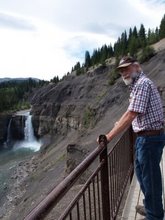 |
| A map of the UK with Doggerland marked as red |
Source: BBC News
A huge area of land which was swallowed up into the North Sea thousands of years ago has been recreated and put on display by scientists.
Doggerland was an area between Northern Scotland, Denmark and the Channel Islands.
It was believed to have been home to tens of thousands of people before it disappeared underwater.
Now its history has been pieced together by artefacts recovered from the seabed and displayed in London.
The 15-year-project has involved St Andrews, Dundee and Aberdeen universities.
The fossilised remains of a mammoth uncovered from the area
The results are on display at the Royal Society Summer Science Exhibition in London until 8 July.
The story behind Doggerland, a land that was slowly submerged by water between 18,000 BC and 5,500 BC, has been organised by Dr Richard Bates at St Andrews University.
Dr Bates, a geophysicist, said "Doggerland was the real heartland of Europe until sea levels rose to give us the UK coastline of today.
"We have speculated for years on the lost land's existence from bones dredged by fishermen all over the North Sea, but it's only since working with oil companies in the last few years that we have been able to re-create what this lost land looked like.
"When the data was first being processed, I thought it unlikely to give us any useful information, however as more area was covered it revealed a vast and complex landscape.
"We have now been able to model its flora and fauna, build up a picture of the ancient people that lived there and begin to understand some of the dramatic events that subsequently changed the land, including the sea rising and a devastating tsunami."
Read BBC article here or related CBS article here
Editor: Here is some more information from Wikipedia on the area, which has been an important fishing ground for many centuries
Dogger Bank is a large sandbank in a shallow area of the North Sea about 100 km (62 mi) off the east coast of England. It extends over approximately 17,600 km2 (6,800 sq mi), with its dimensions being about 160 miles (260 km) long and up to 60 miles (97 km) broad.[1] The water depth ranges from 15 to 36 metres (from 49 to 118 feet), about 20 metres (66 ft) shallower than the surrounding sea. It is a productive fishing bank. The name comes from dogger, an old Dutch word for fishing boat, especially for catching cod.
Geologically, the feature is most likely a moraine, formed during the Pleistocene.[1] At differing times during the last ice age it was land joined to the mainland, or an island. Fishing trawlers working the area have dredged up large amounts of moor peat, remains of mammoth and rhinoceros, and occasionally Paleolithic hunting artefacts. The bank was part of a large landmass, known as Doggerland, which connected Britain to the European mainland until it was flooded at the end of the last ice age.[2] In 1931, the largest earthquake ever recorded in the United Kingdom took place below the bank, measuring 6.1 on the Richter scale. Its focus was 23 km beneath the bank, and the quake was felt in countries all around the North Sea, causing damage across eastern England.


No comments:
Post a Comment